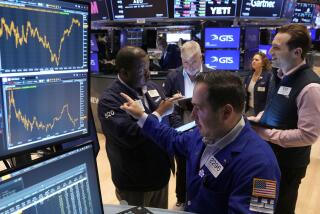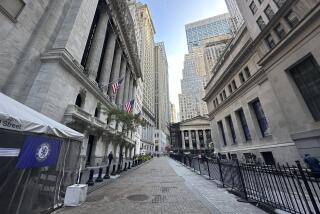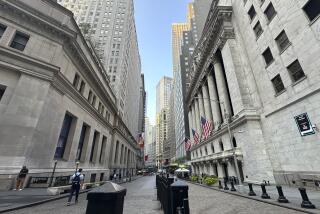NEWS ANALYSIS : Optimism, Lower Interest Rates Fuel Surge in Stocks : Economy: Unusually heavy year-end investing also contributed to the ‘remarkable’ rise, market experts say.
The lowest interest rates in decades, belief in an imminent economic recovery and unusually heavy year-end investing have fueled one of the strongest and fastest stock market rallies in recent years.
On Monday, the Dow Jones industrial average soared 62.39 points to close at a new all-time high of 3,163.91, its third record in three days of trading. The Dow has soared 300 points, or 10.5%, from a fourth-quarter low of 2,863.82 on Dec. 10, creating billions of dollars of wealth for millions of investors--all in the face of a grim economy.
“There is absolutely nothing that is ordinary about a move of this magnitude in the stock market,” said Hugh Johnson, chief investment strategist with First Albany Corp. in New York. “This is truly remarkable. It defies not only words, it defies gravity.”
The rally is happening despite the fact that many individual investors are on the sidelines or are selling their stocks, taking profits out of the market.
Many people are dumbfounded by a stock surge of these proportions and caution that the risks are high. They say that stock prices could retreat as quickly as they surged because of the inexplicable nature of the run-up.
But not everything about the rally is inexplicable. The Federal Reserve Board has cut the discount rate--the interest rate the Fed charges banks--to its lowest level since 1964, and investors feel that the economy will spring back to life.
“The long-term prospects for the economy are better because of interest rates, and, consequently, so are the prospects for stocks,” said Michael Metz, investment strategist with Oppenheimer & Co. in New York.
As a result, many investors, facing 4% and 5% rates of return on certificates of deposit, have pulled their funds out of the banks and opted to take their chances with stock mutual funds or individual company shares, said Michael Hines, senior vice president of Fidelity Investments in Boston.
In addition, with rates this low, stocks that pay cash dividends begin to look more attractive because those dividends can often yield better rates of return than the banks, investment experts say.
To some extent, it is investment by default, said Rao Chalasani, chief investment strategist for Kemper Securities in Chicago.
“Low rates are forcing money out of money market accounts, forcing money out of CDs. The stock market is becoming the singular place for investment,” he said. “It is not a fool’s rally because there is substance behind it. But the substance is something of a default argument. There are very few other places to go.”
This time of year is historically good for the stock market. Investment professionals talk about “Santa Claus rallies” and the “January Effect”--terms for reasonably consistent market hikes that hit right around the New Year’s holiday.
Traditionally, what causes market hikes at this time of year is a combination of tax planning and “window dressing,” investment experts maintain.
Investors tend to sell their money-losing stocks in December so they can take tax losses in April. But then they find themselves flush with cash that needs to be reinvested, and they start buying stocks again.
Meanwhile, institutions that must report their progress to investors each quarter buy up good performers at the end of the year to show that they were clever enough to invest in the year’s winners. The practice is called “window dressing.”
Some of this year’s rally is explained away with these traditional favorites too. The only difference is that stock prices have been strong throughout 1991, so there is less tax selling than usual. And, of course, there are more winners, so there is possibly a touch more window dressing buying than usual too. Both factors tend to push stock prices up.
Market naysayers are also playing a pivotal role in sending stock prices soaring, Metz said.
These market pessimists, called short sellers, have been selling borrowed shares at a near record pace, Metz said. They do this on the assumption that share prices are falling, so when they need to pay back the shares they have borrowed, they will be able to buy the shares at a cheaper price. They plan to make a profit on the difference.
But now, with the rally only getting stronger, short sellers are being forced to buy for fear that prices will go higher and they will lose even more. Already, because they have had to pay back their borrowed shares with more expensive shares, they have lost substantial amounts this year, Metz noted.
All those explanations aside, there is a totally irrational element to today’s rally as well, Johnson said.
“This is approaching a full-fledged mania. A lot of these stocks have become overvalued and overpriced, but the momentum of the market is definitely up,” he said. “What do you do in these circumstances? You close your eyes real tight, plug your nose and jump in.”
Notably, investment professionals often sniff that small investors tend to do all the wrong things at all the wrong times--buying at market peaks and selling at market lows. But individual investors seem to be handling the current rally with skill.
In November, when stock prices took their first major drubbing of the year, small investors were buying at a heady clip, said Mark Thompson, vice president at Charles Schwab & Co. At that point, they were buying about 30% more than they sold, he said. But now that prices are at their all-time highs, individuals have started to take profits, he said. There is now 15% more selling than buying, according to Schwab, a major discount brokerage firm.
“There is a myth that small investors do all the wrong things,” Thompson noted. “But they have done quite nicely in this rally.”
What should small investors be doing? The answer depends on who is talking. Johnson says they should buy. There is no sense investing rationally in an irrational market, he says. Just jump in and hope the rally lasts.
Chalasani said he also thinks investors should get into the stock market, but a bit more cautiously than usual.
“Obviously, the easy money has already been made, so you don’t want to jump in with both feet,” he said. “But it may be time to pick up selective investments.” He suggested buying cyclical stocks, which are those affected by the economy, and convertible bonds, which are debt securities that can be turned into stock.
Chalasani said he particularly likes heavy-industry companies, such as aluminum and paper concerns, as well as auto parts suppliers. He said he is not a fan of shares of big auto makers though, because he thinks these firms may have to work off excess inventory.
He also said he would avoid industries and companies that have seen their share prices soar beyond their earnings capacity. Some food, drug and medical instrumentation and biotechnology firms would fall into this category, he said.
Still, he said he is concerned that all stock prices will suffer if the anticipated economic recovery does not appear by spring. Corporate earnings have to revive substantially to make today’s stock prices worthwhile, he said.
However, Geraldine Weiss, editor of Investment Quality Trends, a La Jolla-based investment newsletter, said she thinks investors ought to consider getting out of the stock market.
“This appears to be the last gasp of the market rally, and there are very frightening indications that today’s prices are unsustainable,” she said. She’s expecting a substantial drop in stock prices some time in 1992.
RELATED STORY: D1
More to Read
Inside the business of entertainment
The Wide Shot brings you news, analysis and insights on everything from streaming wars to production — and what it all means for the future.
You may occasionally receive promotional content from the Los Angeles Times.










